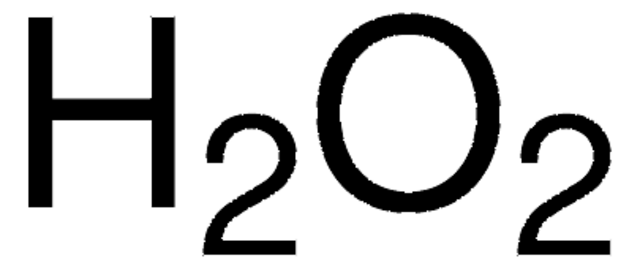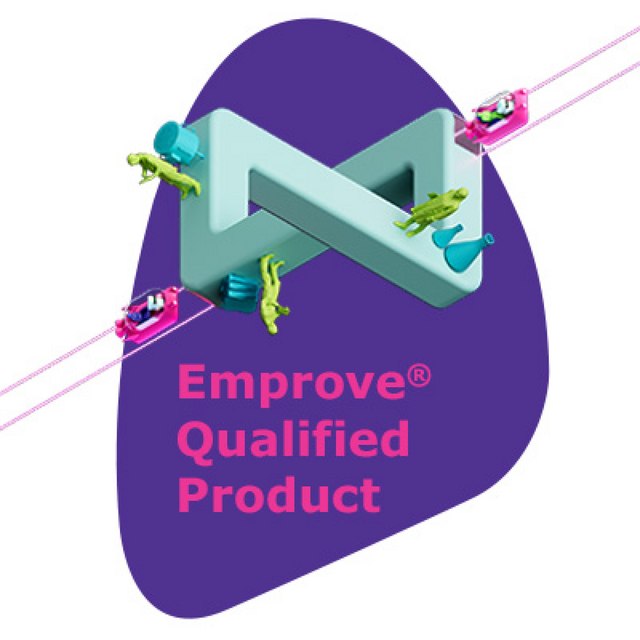Key Documents
Safety Information
16911
Hydrogen peroxide solution
30 % (w/w), for ultratrace analysis
About This Item
Recommended Products
vapor pressure
23.3 mmHg ( 30 °C)
Quality Level
description
for inorganic trace analysis
form
liquid
shelf life
~5 yr
concentration
25-35%
30 % (w/w)
density
1.11 g/mL at 20 °C
anion traces
bromide (Br-): ≤10 μg/kg
chloride (Cl-): ≤25 μg/kg
fluoride (F-): ≤1000 μg/kg
nitrate (NO3-): ≤250 μg/kg
phosphate (PO43-): ≤25 μg/kg
sulfate (SO42-): ≤50 μg/kg
cation traces
Ag: ≤0.01 μg/kg
Al: ≤0.2 μg/kg
As: ≤0.05 μg/kg
Au: ≤0.01 μg/kg
B: ≤0.3 μg/kg
Ba: ≤0.05 μg/kg
Be: ≤0.01 μg/kg
Bi: ≤0.01 μg/kg
Ca: ≤2 μg/kg
Cd: ≤0.01 μg/kg
Ce: ≤0.01 μg/kg
Co: ≤0.01 μg/kg
Cr: ≤0.05 μg/kg
Cs: ≤0.01 μg/kg
Cu: ≤0.05 μg/kg
Dy: ≤0.01 μg/kg
Er: ≤0.01 μg/kg
Eu: ≤0.01 μg/kg
Fe: ≤0.2 μg/kg
Ga: ≤0.01 μg/kg
Gd: ≤0.01 μg/kg
Ge: ≤0.01 μg/kg
Hf: ≤0.01 μg/kg
Hg: ≤0.1 μg/kg
Ho: ≤0.01 μg/kg
In: ≤0.01 μg/kg
Ir: ≤0.01 μg/kg
K: ≤0.5 μg/kg
La: ≤0.01 μg/kg
Li: ≤0.01 μg/kg
Lu: ≤0.01 μg/kg
Mg: ≤0.2 μg/kg
Mn: ≤0.01 μg/kg
Mo: ≤0.01 μg/kg
N: ≤2000 μg/kg
Na: ≤0.5 μg/kg
Nb: ≤0.01 μg/kg
Nd: ≤0.01 μg/kg
Ni: ≤0.05 μg/kg
Os: ≤0.05 μg/kg
Pb: ≤0.1 μg/kg
Pd: ≤0.01 μg/kg
Pr: ≤0.01 μg/kg
Pt: ≤0.1 μg/kg
Rb: ≤0.01 μg/kg
Re: ≤0.01 μg/kg
Rh: ≤0.01 μg/kg
Ru: ≤0.01 μg/kg
Sb: ≤0.02 μg/kg
Sc: ≤0.05 μg/kg
Se: ≤0.05 μg/kg
Sm: ≤0.01 μg/kg
Sn: ≤0.01 μg/kg
Sr: ≤0.01 μg/kg
Tb: ≤0.01 μg/kg
Te: ≤0.01 μg/kg
Th: ≤0.01 μg/kg
Ti: ≤0.1 μg/kg
Tl: ≤0.01 μg/kg
Tm: ≤0.01 μg/kg
U: ≤0.01 μg/kg
V: ≤0.01 μg/kg
W: ≤0.02 μg/kg
Y: ≤0.01 μg/kg
Yb: ≤0.01 μg/kg
Zn: ≤0.2 μg/kg
Zr: ≤0.01 μg/kg
SMILES string
OO
Looking for similar products? Visit Product Comparison Guide
1 of 4
This Item | 88597 | H1009 | 18304 |
|---|---|---|---|
| grade for inorganic trace analysis, for ultratrace analysis | grade - | grade - | grade - |
| Quality Level 100 | Quality Level 200 | Quality Level 200 | Quality Level 200 |
| form liquid | form solution | form liquid | form - |
| storage temp. 2-8°C | storage temp. - | storage temp. 2-8°C | storage temp. 2-8°C |
| anion traces bromide (Br-): ≤10 μg/kg, fluoride (F-): ≤1000 μg/kg, phosphate (PO43-): ≤25 μg/kg, chloride (Cl-): ≤25 μg/kg, sulfate (SO42-): ≤50 μg/kg, nitrate (NO3-): ≤250 μg/kg | anion traces - | anion traces - | anion traces - |
Application
- Smartphone-Integrated Automated Sensor Employing Electrochemically Engineered 3D Bimetallic Nanoflowers for Hydrogen Peroxide Quantification in Milk: This innovative study demonstrates the application of high-purity hydrogen peroxide in the development of a sensor for detecting hydrogen peroxide levels in milk, integrating advanced technology for food safety and quality assurance (Kumari et al., 2024).
- Assessment of new hydrogen peroxide activators in water and comparison of their active species toward contaminants of emerging concern: This study uses hydrogen peroxide solutions to evaluate new activators for water treatment processes, demonstrating their critical role in environmental testing and remediation efforts (Farinelli et al., 2024).
- Albumin suppresses oxidation of Ti-Nb alloy in the simulated inflammatory environment: In material science research, hydrogen peroxide solutions are applied to study the oxidative resistance of biomedical alloys, highlighting their importance in developing durable and safe medical implants (Sotniczuk et al., 2024).
Signal Word
Danger
Hazard Statements
Precautionary Statements
Hazard Classifications
Acute Tox. 4 Oral - Aquatic Chronic 3 - Eye Dam. 1
Storage Class Code
5.1B - Oxidizing hazardous materials
WGK
WGK 1
Flash Point(F)
Not applicable
Flash Point(C)
Not applicable
Personal Protective Equipment
Regulatory Information
Choose from one of the most recent versions:
Already Own This Product?
Find documentation for the products that you have recently purchased in the Document Library.
What is the molarity of the 30% hydrogen peroxide solution?
The molarity of a 30 % hydrogen peroxide solution is 9.8 M based on a density of 1.11 g/ml.
How stable is the 30 % hydrogen peroxide solution?
Although dilute solutions of hydrogen peroxide have a limited shelf life, the 30% solution (when properly stored) has a shelf life measured in years. Please see the certificate of analysis for the recommend retest date for a particular lot of Product No. 16911.
Can hydrogen peroxide be detected spectrophotometrically?
Hydrogen peroxide has a molar extinction coefficient of 43.6 at 240 nm.
What is the pH of a 30% hydrogen peroxide solution?
The pH of a 30 % hydrogen peroxide solution is typically between 3 and 4.
Which document(s) contains shelf-life or expiration date information for a given product?
If available for a given product, the recommended re-test date or the expiration date can be found on the Certificate of Analysis.
How do I get lot-specific information or a Certificate of Analysis?
The lot specific COA document can be found by entering the lot number above under the "Documents" section.
How do I find price and availability?
There are several ways to find pricing and availability for our products. Once you log onto our website, you will find the price and availability displayed on the product detail page. You can contact any of our Customer Sales and Service offices to receive a quote. USA customers: 1-800-325-3010 or view local office numbers.
What is the Department of Transportation shipping information for this product?
Transportation information can be found in Section 14 of the product's (M)SDS.To access the shipping information for this material, use the link on the product detail page for the product.
My question is not addressed here, how can I contact Technical Service for assistance?
Ask a Scientist here.
Our team of scientists has experience in all areas of research including Life Science, Material Science, Chemical Synthesis, Chromatography, Analytical and many others.
Contact Technical Service


